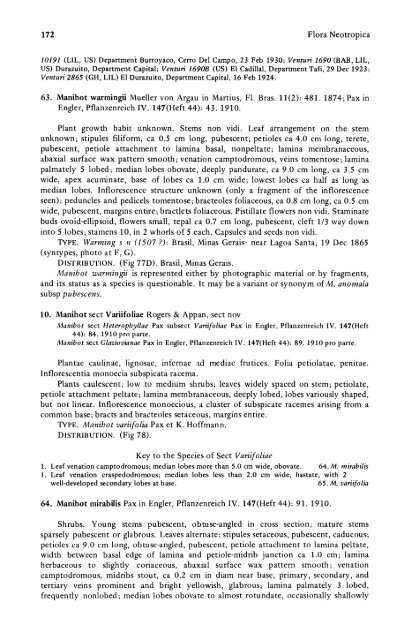Manihot Manihotoides (Euphorbiaceae) - CNCFlora
Manihot Manihotoides (Euphorbiaceae) - CNCFlora
Manihot Manihotoides (Euphorbiaceae) - CNCFlora
You also want an ePaper? Increase the reach of your titles
YUMPU automatically turns print PDFs into web optimized ePapers that Google loves.
172 Flora Neotropica<br />
10191 (LIL, US) Department Burroyaco, Cerro Del Campo, 23 Feb 1930; Venturi 1690 (BAB, LIL,<br />
US) Durazuito, Department Capital; Venturi 1690B (US) El Cadillal, Department Tafi, 29 Dec 1923;<br />
Venturi 2865 (GH, LIL) El Durazuito, Department Capital, 16 Feb 1924.<br />
63. <strong>Manihot</strong> warmingii Mueller von Argau in Martius, Fl. Bras. 11(2): 481. 1874; Pax in<br />
Engler, Pflanzenreich IV. 147(Heft 44): 43. 1910.<br />
Plant growth habit unknown. Stems non vidi. Leaf arrangement on the stem<br />
unknown; stipules filiform, ca 0.5 cm long, pubescent; petioles ca 4.0 cm long, terete,<br />
pubescent, petiole attachment to lamina basal, nonpeltate; lamina membranaceous,<br />
abaxial surface wax pattern smooth; venation camptodromous, veins tomentose; lamina<br />
palmately 5 lobed; median lobes obovate, deeply pandurate, ca 9.0 cm long, ca 3.5 cm<br />
wide, apex acuminate, base of lobes ca 1.0 cm wide; lowest lobes ca half as long as<br />
median lobes. Inflorescence structure unknown (only a fragment of the inflorescence<br />
seen); peduncles and pedicels tomentose; bracteoles foliaceous, ca 0.8 cm long, ca 0.5 cm<br />
wide, pubescent, margins entire; bractlets foliaceous. Pistillate flowers non vidi. Staminate<br />
buds ovoid-ellipsoid, flowers small, tepal ca 0.7 cm long, pubescent, cleft 1/3 way down<br />
into 5 lobes; stamens 10, in 2 whorls of 5 each. Capsules and seeds non vidi.<br />
TYPE. Warming s n (1507 ?): Brasil, Minas Gerais: near Lagoa Santa, 19 Dec 1865<br />
(syntypes, photo at F, G).<br />
DISTRIBUTION. (Fig 77D). Brasil, Minas Gerais.<br />
Manibot warmingii is represented either by photographic material or by fragments,<br />
and its status as a species is questionable. It may be a variant or synonym of M. anomala<br />
subsp pubescens.<br />
10. <strong>Manihot</strong> sect Variifoliae Rogers & Appan, sect nov<br />
<strong>Manihot</strong> sect Heteropbyllae Pax subsect Variifoliae Pax in Engler, Pflanzenreich IV. 147(Heft<br />
44): 84. 1910 pro parte.<br />
<strong>Manihot</strong> sect Glaziovianae Pax in Engler, Pflanzenreich IV. 147(Heft 44): 89. 1910 pro parte.<br />
Plantae caulinae, lignosae, infernae ad mediae frutices. Folia petiolatae, penitae.<br />
Inflorescentia monoecia subspicata racema.<br />
Plants caulescent; low to medium shrubs; leaves widely spaced on stem; petiolate,<br />
petiole attachment peltate; lamina membranaceous, deeply lobed, lobes variously shaped,<br />
but not linear. Inflorescence monoecious, a cluster of subspicate racemes arising from a<br />
common base; bracts and bracteoles setaceous, margins entire.<br />
TYPE. <strong>Manihot</strong> variifolia Pax et K. Hoffmann.<br />
DISTRIBUTION. (Fig 78).<br />
Key to the Species of Sect Variifoliae<br />
1. Leaf venation camptodromous; median lobes more than 5.0 cm wide, obovate. 64. M. mirabilis<br />
1. Leaf venation craspedodromous; median lobes less than 2.0 cm wide, hastate, with 2<br />
well-developed secondary lobes at base. 65. M. variifolia<br />
64. <strong>Manihot</strong> mirabilis Pax in Engler, Pflanzenreich IV. 147(Heft 44): 91. 1910.<br />
Shrubs. Young stems pubescent, obtuse-angled in cross section; mature stems<br />
sparsely pubescent or glabrous. Leaves alternate; stipules setaceous, pubescent, caducous;<br />
petioles ca 9.0 cm long, obtuse-angled, pubescent, petiole attachment to lamina peltate,<br />
width between basal edge of lamina and petiole-midrib junction ca 1.0 cm; lamina<br />
herbaceous to slightly coriaceous, abaxial surface wax pattern smooth; venation<br />
camptodromous, midribs stout, ca 0.2 cm in diam near base, primary, secondary, and<br />
tertiary veins prominent and bright yellowish, glabrous; lamina palmately 3 lobed,<br />
frequently nonlobed; median lobes obovate to almost rotundate, occasionally shallowly

















